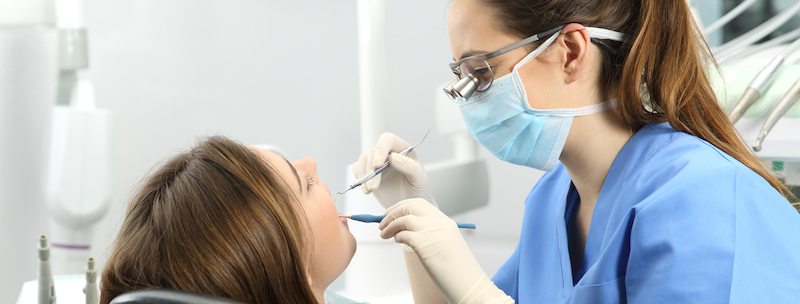Dental ergonomics is a science dedicated to optimizing your work environment and mitigating the risk of workplace-related injuries. Using ergonomics in your daily work not only benefits you; it can also enhance your patients’ experience and increase treatment efficiency and accuracy.
In this article, we will define ergonomics and discuss essential tools and ergonomic products for dental hygienists.
What is Ergonomics?
In dentistry, ergonomics is studying how dental professionals can improve their environment and positioning to reduce the risk of injury and prevent musculoskeletal problems. Maintaining a natural and comfortable position benefits the hygienist and can also improve patient experience, treatment efficiency, and accuracy.
As a dental hygienist, you often spend long hours performing precise and intricate procedures. Poor ergonomics can lead to chronic pain, musculoskeletal issues, and reduced job satisfaction. By implementing ergonomic principles into your daily work routine, you can improve your well-being and the quality of patient care you can provide.
Essential Dental Hygienist Tools
As a dental hygienist, you rely on a variety of essential tools to provide comprehensive oral care to your patients. Here’s an expanded look at some of these crucial dental hygienist instruments. Keep in mind that there are ergonomic versions of many of these products on the market!
- Scalers: An essential in any dental hygienist’s toolkit, a dental scaler is a hand-held instrument that has a hook or curved blade at the end. This tool is commonly used to remove the hardened plaque that builds up between your patients’ teeth.
- Dental Probes: This tool is particularly useful in assessing the pocket depth between the gum and the tooth, which helps in the early detection of gum disease. Dental probes can also be used to measure the width of teeth and identify overbite, helping the diagnosis and treatment planning process.
- Polishers: Used for both dental hygiene and cosmetic dentistry, polishers are used to smooth and polish the surfaces of teeth and dental restorations. Whether it’s enhancing natural teeth, refining the fit of dental prostheses, or improving the aesthetics of cosmetic procedures, polishers are versatile tools that every dental hygienist should be familiar with.
- Curettes: These specialized instruments are characterized by their rounded tips. The versatile tool is used to eliminate stains, supragingival (above the gum line) and subgingival (below the gum line) calculus, and plaque. Curettes are essential in root planing procedures, a crucial step in treating gum disease and maintaining gum health.
- Periodontal Probes: This tool helps assess periodontal health by measuring the depth of gum pockets accurately. By providing precise measurements, this tool allows dental hygienists to track changes in gum health over time and tailor treatment plans accordingly.
- Intraoral cameras: With new advances in dentistry, intraoral cameras have become an invaluable tool. The small, handheld device can take high-resolution images of the mouth, allowing hygienists to show patients their oral health conditions in real time. This can enhance patient understanding of and engagement in their treatment plan.
Ergonomic Products for Dental Hygienists
Studies have shown that more than 96% of dental hygienists experience pain due to work-related activities. The most common areas affected are the neck, shoulders, lower back, hands, and wrists. Because of this, investing in ergonomic products and doing stretches for dental hygienists can greatly reduce your risk of work-related pain. Some of the most popular ergonomic products for dental hygienists include:
- Ergonomic Loupes: Designed to promote a more ergonomic posture while working, these loupes encourage you to maintain a straighter back and neck alignment while working on your dental patient. This can minimize the musculoskeletal problems that can arise from prolonged periods of poor posture.
- Ergonomic Dental Chairs: Look into this specialized type of dental chair engineered with features that promote good posture and support your spine while letting you work at a comfortable angle. Ergonomic dental chairs help reduce leg strain, neck pain, and the risk of injury from repetitive motion.
- Clove Shoes: This shoe brand is specifically designed for healthcare workers. With three layers of cushions, Clove shoes reduce the pain and fatigue associated with standing for long periods of time.
- Right- and Left-Fitted Gloves: Traditional ambidextrous gloves were originally meant to be worn for quick procedures. Wearing them for longer periods of time can put unnecessary strain on your thumbs. Right- and left-fitted gloves are anatomically correct, allowing for greater blood flow and range of motion, which can relieve overworked muscles and increase comfort levels during long procedures.
- Ergonomic Dental Instruments: There are plenty of dental tools on the market that merge precision with comfort. Because they are engineered to reduce strain and increase range of motion, these instruments can help transform dental procedures into a seamless experience for both you and your patients. Ergonomic grips, adjustable angles, and balanced weights promote proper hand posture, which can mitigate fatigue during extended treatments. With ergonomic dental instruments, you can achieve exceptional accuracy while prioritizing your own well-being and delivering the best care possible.
In conclusion, integrating dental ergonomics into your daily routine is a win-win situation, benefiting both you and your patients. By prioritizing proper positioning and utilizing ergonomic tools and products, you can create a more comfortable and efficient work environment, leading to better patient experiences and treatment outcomes.




